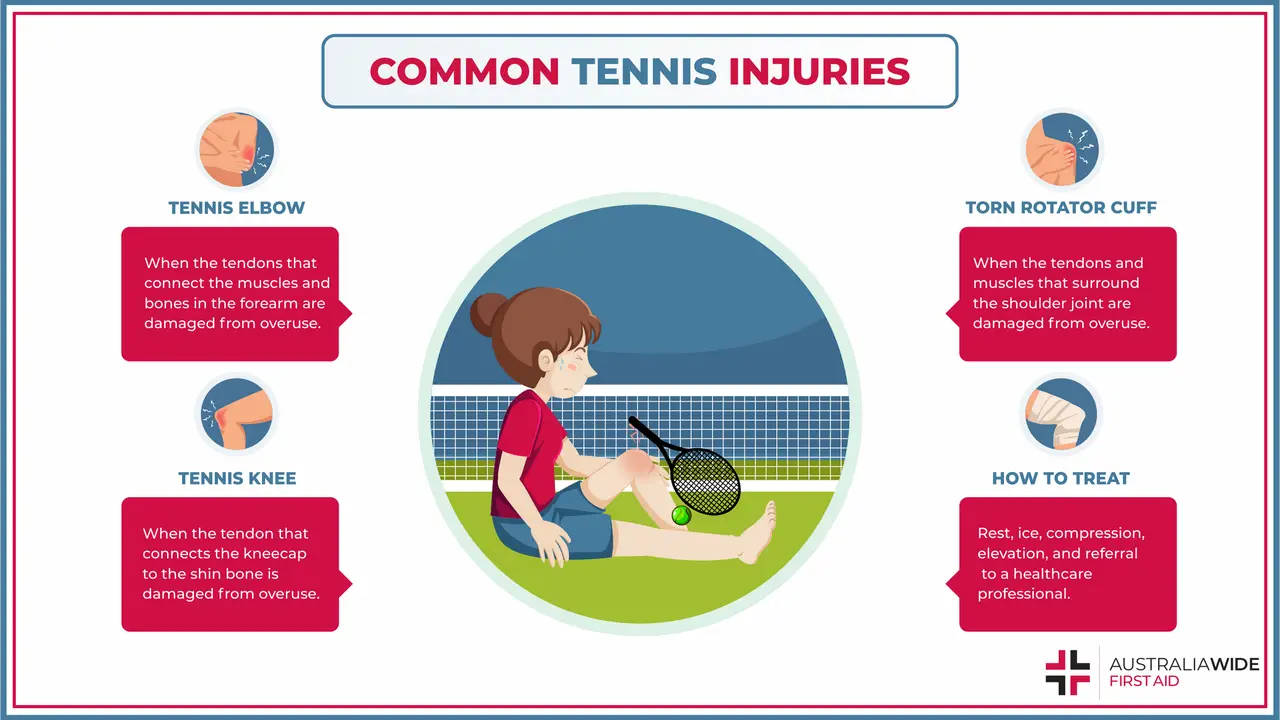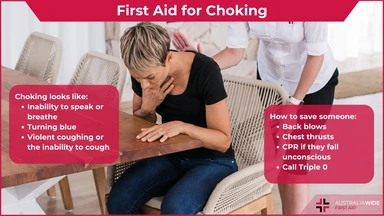First Aid for Tennis


Tennis is a racquet sport that can be played individually or as a pair.
According to Tennis Australia, tennis was the fastest growing sport across all ages at the conclusion of 2021, with over 1.5 million Australians signing up for the 2021/2022 tennis season.
It is unsurprising that tennis is becoming increasingly popular among younger generations. Tennis is known to improve aerobic capacity and muscle tone, while simultaneously reducing stress and body fat. Likewise, tennis clubs provide a great opportunity for players to socialise with like-minded people.
However, as with most sports, tennis is not without injury.
Continue reading for a closer look at the benefits of tennis, as well as the most common injuries among tennis players and how to treat them.
If you have ever watched a tennis match, you will have noticed that tennis players constantly move across the court, and they stretch out their arms and legs to reach the ball and keep it in play. This helps improve their flexibility and agility.
The constant running and jumping also helps tone the muscles in their lower body, while the alternate use of forehands and backhands to hit the ball helps improve the muscles in their upper body and core.
Tennis is also a tonic for good bone health, as the impact of hitting the ball and bounding across the court improves bone density. Bone density refers to the amount of bone mineral in bone tissue. People with low bone density are more likely to develop osteoporosis, a condition in which the bones become weak, brittle, and prone to breaking.
As tennis players are constantly moving, even while standing in the one spot, their heart is constantly pumping oxygen and nutrients to the working muscles. This improves the strength and efficiency of their heart, and subsequently reduces their risk of cardiovascular disease, including heart attack, coronary artery disease, and arrhythmias.
Tennis is a tactical sport, as players must anticipate what their opponent will do next. This helps improve their critical thinking and planning skills, as well as generate new connections between nerves in the brain.
As with all forms of exercise, tennis also triggers the brain to release endorphins and serotonin. Endorphins act as analgesics and diminish the perception of pain while reducing stress. Serotonin, meanwhile, is considered a natural mood stabiliser and helps regulate digestion, wound healing, and bone health (among others).
Tennis Elbow, also known as lateral epicondylitis, is a painful condition in which the tendons that connect the muscles and bones in the forearm are damaged from overuse.
Tennis Elbow occurs when the forearm muscles are repeatedly contracted to straighten and raise the hand and wrist. This condition is not just common among tennis players, but also painters, plumbers, and people who enjoy gardening.
As with most overuse injuries, the symptoms of tennis elbow do not start with a specific injury, but instead develop and worsen over time. Symptoms can include:
These symptoms tend to worsen during activities that engage the forearm, such as:
The rotator cuff is a group of muscles and tendons that surround the shoulder joint. It is responsible for holding the shoulder joint in place, and for allowing the arms to move up and away from the body.
As with Tennis Elbow, rotator cuff injuries are generally caused by overuse; specifically, when the shoulder is repeatedly moved in the same direction.
It is especially common in people who repeatedly lift their arms overhead. As such, it does not only occur among tennis players, but also baseball pitchers, painters, and carpenters.
Common symptoms include:
Tennis Knee, also known as patellar tendonitis, is an overuse injury of the patellar tendon, the tendon that connects the kneecap to the shin bone.
Tennis Knee occurs when a person frequently jumps or lands on hard surfaces, which can stress the patellar tendon and cause it to tear.
As well as tennis players, this condition is known to occur in basketballers and netballers. It is characterised by:
The most common injuries among tennis players, like the ones mentioned above, tend to be soft tissue injuries. As such, they can be treated with the RICER protocol:
Within the first 48 – 72 hours of receiving a soft tissue injury, it is also essential to apply the ‘Avoid HARM’ protocol. Avoid the following:
Pain relief, such as Paracetamol or Ibuprofen, can be used to keep you comfortable, assist with healing, and help you move around after the initial injury. Make sure to follow the directions on the packet.
Tennis is a racquet sport that is becoming increasingly popular in Australia, and for good reason.
Tennis provides numerous physical and emotional health benefits. For instance, it can help players improve their muscle tone, bone strength, and aerobic capacity, as well as increase the amount of nerve connections and happy hormones in the brain.
Tennis clubs also help bring like-minded people together, and socialising is a fantastic way to increase one's self-esteem and optimism.
However, as with most sports, tennis is not without injury, and players are prone to soft tissue injuries like Tennis Elbow, Tennis Knee, and a Torn Rotator Cuff. Luckily, most soft tissue injuries can be treated with the RICER protocol.
We hope you enjoyed learning about common tennis injuries. If you would like to learn more about how to identify, prevent, and treat a wide range of soft tissue injuries, book a First Aid course with Australia Wide First Aid today.

October 13, 2023
Choking occurs when an object or a piece of food becomes lodged in the throat, blocking the airway. The adult or child will have difficulty breathing, and may lose consciousness. Quick and effective action is essential to prevent severe consequences and death.

September 22, 2023
Knowing how to provide first aid for fluid draining from an ear is crucial to alleviate discomfort and potentially prevent complications.

July 31, 2023
This article covers treatment/first aid for nose bleeds, and also covers all of the common misconceptions and myths about treating a bleeding nose.